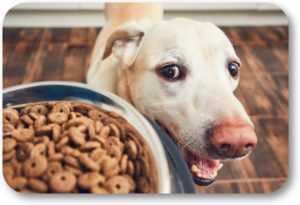I was at a new Home Dog Training client in Dacula last Tuesday working with him, his family, and his three-year-old Labrador Retriever named Angus. Angus was a great dog, but like most Labs, a little crazy with “alternative focus”. These items could easily be mitigated through proper communication and the establishment of an appropriate hierarchy between Angus, my client, and his family. We solved these issues and moved on to obedience and other behavior problems.

Angus, like many dogs, loved mealtime. He would go crazy, jump on anyone with a dog bowl, and often knocked his kibble to the ground. At that point, he would turn into a “canine vacuum cleaner” and inhale all the scattered kibble. This, obviously, was one of the problems we successfully resolved. With that said, I would like to share our process with you.
We first have to think what is going through Angus’ head as he is going for the food. He is acting like a spoiled, “human brat” grabbing food from the middle of the table instead of waiting to be served. This happens when he thinks he is the boss and has no respect or focus on the “rest of the family around the table”. Just as we need to deal with the “spoiled, human brat”, we need to deal with Angus.
He must initially understand that he is not the boss and the world does not revolve around him. That is what I first accomplished through my overall training process with my clients. Once he has this firmly established in his “canine head”, we can proceed to making mealtime polite and calm. The most important thing that we must remember through the entire process is that WE are in charge, and WE are allowing Angus to have his dinner. Here are some simple suggestions to make this happen:
- Have your dog on a leash with a second person holding the leash. Place him in a location about ten to fifteen feet away from where you will be feeding him. He should be able to have a clear line of sight to the dog bowl area and the area that you will be preparing his meal.
- Place him in a Sit and Stay. He should remain calm as the person holding the leash allows the leash to have enough slack to hang freely.
- He must remain in place as you prepare his meal. Take your time in your actions. Remember that you are the boss and the entire process is on your terms at your speed.
- Place the food bowl and water bowl on the ground, stand up, and face him.
- If he leaves the Stay, the person next to him should immediately give a strong tug to the leash. Both of you should correct him to let him know that his action is unacceptable. Place him back in a Stay at the original location.
- He needs to remain calm and still during and after you have put the food bowls down. Wait for about five seconds to assure that this is being accomplished.
- Stoop down low and give him the Come command.
- He should now calmly walk to you as the other person is following, holding the leash loosely. If your dog starts to run or become excited, the other person should give the lash a firm tug to divert his adrenaline and calm him.
- Once he has reached you, stand up to reaffirm your dominance. Do not let him close enough to his food and water bowls to allow him to start eating.
- Give him the sit command in front of the food and water bowls. Have him remain calm and in a sitting stance in front of the food and water bowls for about three to five seconds.
- You can now give him your “Eat” command. It may be verbal or a hand gesture showing him that you have been in charge through the entire process and are now allowing him to have his dinner.
- If your dog is a “super-fast eater”, we suggest that you get a “slow-feeder” bowl. This is a dog bowl that looks like it has a “Pac Man” maze in it. It will keep him from “inhaling his food”. When dogs eat too quickly, sometimes their stomachs will “flip”. This will require an immediate visit to the Veterinarian Hospital and possible surgery. The “slow-feeder” removes this possibility.
It is my, personal opinion that we feed our dog a meal and not present them with a buffet. This means that, once I put the food down, I don’t leave it down indefinitely. I pick our dogs’ bowls up after twenty to thirty minutes. This is equivalent to “the kitchen is closed”. It also demonstrates to my dogs that I am still in charge of the food and when they eat.
Please call Robin or me at (770) 718-7704 if you need any dog training help. We are blessed to have been your local dog training professionals for over seventeen years. We have trained over 5,000 great dogs and loving families and are ready to help you.

Follow Us!